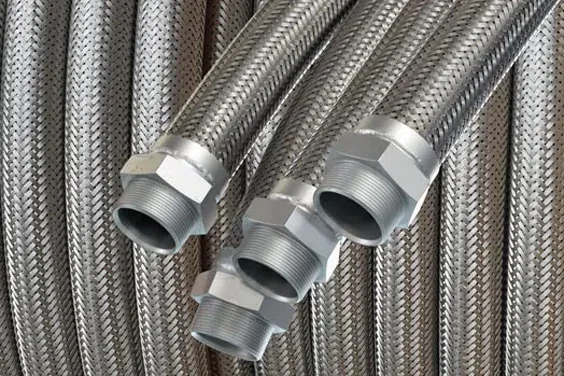Stainless steel (SS) hoses are integral components in a variety of industries, including manufacturing, food processing, pharmaceuticals, and automotive. Their durability and resistance to corrosion make them a popular choice for handling fluids and gases in challenging environments. However, like all mechanical components, SS hoses can wear out or get damaged over time. Understanding innovative solutions for SS hose repair is crucial for maintaining operational efficiency and safety.
Understanding SS Hoses
Before diving into repair solutions, it’s important to understand the role of SS hoses. These hoses are designed to withstand high temperatures and pressures, making them ideal for applications where flexibility and strength are required. Their construction typically includes a stainless steel outer layer and a flexible inner core that can handle various substances, from water to harsh chemicals.
Common Issues with SS Hoses
Despite their robust construction, SS hoses can face several challenges:
- Corrosion and Rust: While stainless steel is resistant to rust, it can still corrode under certain conditions, particularly in the presence of chlorides or high levels of humidity.
- Cracking and Leaks: Over time, the repeated stress of flexing can lead to cracking, especially at the joints or fittings.
- Bursting: Extreme pressure beyond the hose’s capacity can lead to bursting, which poses a significant safety risk.
- Improper Installation: If hoses are not installed correctly, they may experience premature failure due to kinking or excessive bending.
Recognizing these issues early can prevent more severe problems down the line.
Innovative Repair Techniques
When it comes to repairing SS hoses, traditional methods may not always suffice. Here are some innovative solutions that can extend the life of your SS hoses and improve overall system performance.
1. Advanced Welding Techniques
One of the most effective ways to repair damaged SS hoses is through advanced welding techniques. Methods such as TIG (Tungsten Inert Gas) welding allow for precise repairs without compromising the structural integrity of the hose. This technique is particularly useful for repairing cracks or splits in the hose material.
Benefits:
- Creates strong, durable repairs
- Maintains the original properties of the stainless steel
- Can be applied to a variety of hose sizes and configurations
2. Flexible Hose Couplings
Flexible couplings offer a quick and effective solution for connecting damaged hoses. These couplings can be installed with minimal downtime and allow for easy disassembly when needed. They are particularly useful in applications where hoses need to be replaced frequently.
Benefits:
- Facilitates quick repairs and replacements
- Reduces the need for extensive rework
- Enhances flexibility in hose configurations
3. Use of Hose Clamps
Hose clamps can provide temporary or even permanent fixes for leaking hoses. By securing the damaged area with a clamp, you can prevent further leakage while exploring more permanent repair options. This solution is particularly useful for minor leaks and can often be implemented on-site.
Benefits:
- Quick and easy to install
- Provides immediate relief from leaks
- Cost-effective for minor repairs
4. Sealants and Adhesives
High-performance sealants and adhesives designed for stainless steel applications can be effective in repairing small cracks or leaks. These materials bond with the stainless steel to create a strong seal that can withstand high pressures and temperatures.
Benefits:
- Simple application process
- Effective for small repairs
- Can extend the life of a hose before more significant repairs are necessary
5. Reinforcement with Sleeves
For hoses experiencing wear in high-stress areas, using reinforcement sleeves can be an innovative way to prevent damage. These sleeves can be made from various materials, including silicone or other flexible polymers, and are designed to provide extra support to vulnerable sections of the hose.
Benefits:
- Enhances the durability of the hose
- Prevents premature wear in critical areas
- Easy to apply and remove
Maintenance Tips for Longevity
Repairing SS hoses is important, but preventing damage in the first place is even better. Here are some maintenance tips to help extend the life of your hoses:
- Regular Inspections: Schedule routine inspections to check for signs of wear, corrosion, or damage. Early detection can save you time and money on repairs.
- Proper Installation: Ensure that hoses are installed according to manufacturer guidelines. Avoid sharp bends, kinks, or unnecessary tension on the hoses.
- Use the Right Hose for the Job: Selecting hoses designed for specific applications can reduce wear and tear. Consider factors such as pressure, temperature, and the type of fluids being transported.
- Cleanliness is Key: Keep hoses free from contaminants. Regular cleaning can prevent build-up that may lead to corrosion or other forms of damage.
- Monitor Operating Conditions: Be aware of the conditions in which your SS hoses operate. Extreme temperatures or pressures can exacerbate wear and lead to premature failure.
SS hoses are invaluable components in various industries, but they require proper care and innovative repair solutions to ensure their longevity and effectiveness. By understanding common issues and exploring advanced repair techniques such as welding, flexible couplings, and the use of sealants, you can enhance the durability of your hoses. Additionally, implementing regular maintenance practices will help you identify potential problems early, minimizing downtime and ensuring safe operations.
Investing in the right solutions for SS hose repair not only keeps your systems running smoothly but also contributes to a safer working environment. With the right knowledge and tools, you can tackle any hose repair challenge that comes your way.







